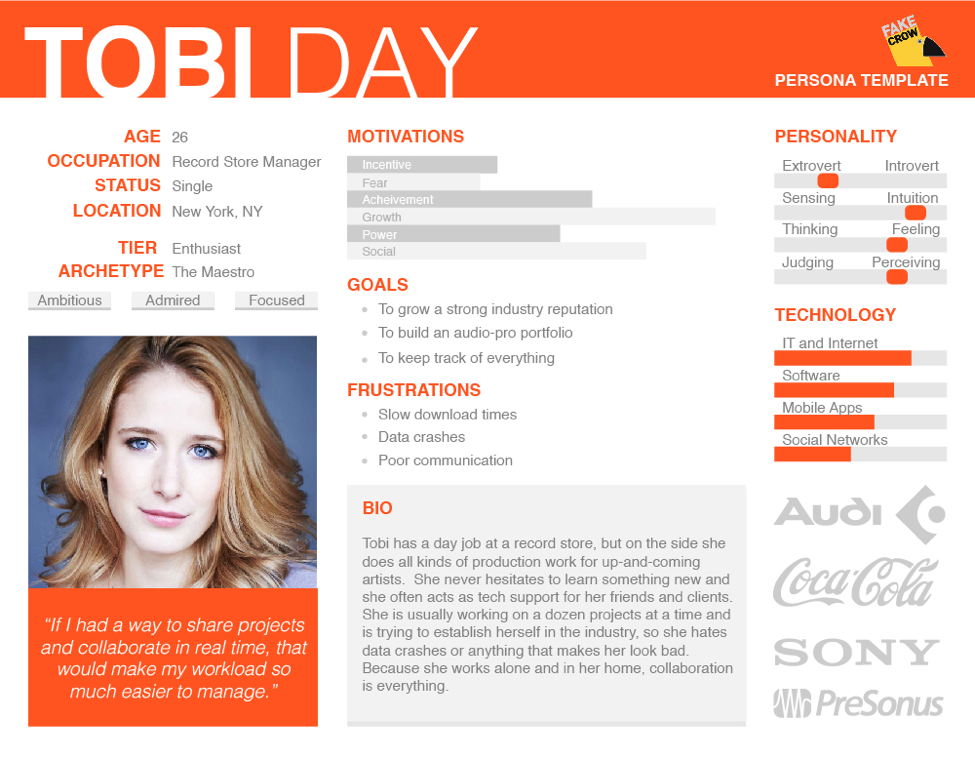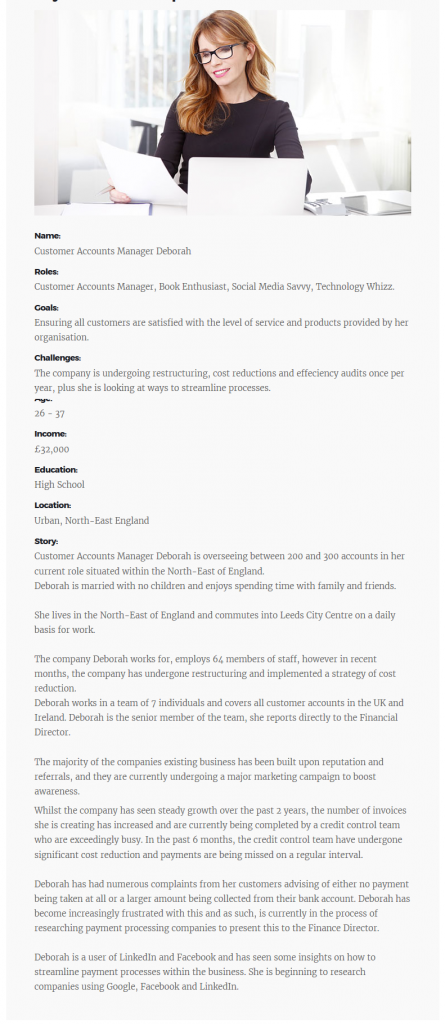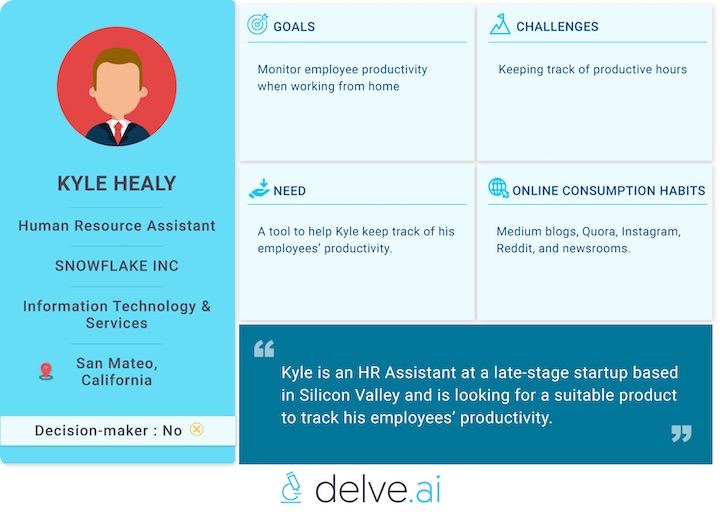Despite the growing evidence that buyer personas are a valuable asset that can boost lead generation efforts, only around 44% of B2B marketers use them as part of their content strategy.
This is a massive opportunity wasted and could be a chance to not only improve your marketing strategy but secure more leads for your business.
However, when buyer personas aren’t well-researched, they are just a waste of time and never get properly utilized by either marketing or sales teams.
In this post, we’ll cover how you create an effective buyer persona, how to conduct market research, and how you can use it to improve your content marketing strategy (plus, we’ve included some great examples to give you some inspiration).
Already have an effective buyer persona? Let the team at bant.io leverage that key data into high-converting email campaigns that get consistent leads for your business every single month. Request a demo with us today and we’ll show you how it works.
Why You Should Create B2B Buyer Personas
Around half of all B2B buyers report they are more likely to do business with a company that has used personalized marketing strategies.
Buying personas allow you to create personalized marketing messages that target your ideal audience much more effectively, boosting your overall marketing efforts.
A buying persona is just a representation of customers, but it allows you to understand their wants and needs much better, which in turn makes marketing much easier.
And if you’re still not convinced creating personas is a good use of your time, consider that companies that use ideal buyer personas have a 73% higher conversion rate than those that don’t.
Generate more leads
The ultimate goal of buyer personas is to make generating leads easier and more effective. When you have more high-quality leads coming into your business every month, the job of your sales team is much more streamlined.
The only way to increase your lead generation is to understand your customers better. And the only way to do that is with well-crafted buyer personas.
So, if your company is struggling to generate consistent leads, this is a crucial exercise you should be doing to nudge your potential buyers to that all-important decision stage.
How Many Buyer Personas Should I Have?
Many marketers will tell you that you should have a different buyer persona for each product or service you offer. And although most companies will need more than one, having too many different personas will dilute your messaging.
With too many personas, not only will your marketing become much more difficult to keep track of, but it will also make it more difficult for your sales team to give a consistent pitch.
A good rule of thumb is to have a different persona for each industry or vertical you target (rather than a different one for each product or service).
This way, you can spend more time creating detailed personas for each industry and make your marketing efforts more focused.
How to Gather B2B Persona Information

Now you know how many personas you should start with, you’ll need to start gathering the necessary information to create them.
You’ll want a mix of quantitative and qualitative data, and the more detailed you can get, the better.
Here are some ideas of where to begin gathering data:
- Your CRM data
If you have a good quality CRM system, this will be a gold mine of information on your audience’s buying behavior.
Take a look at your sales pipeline and see whether your prospects are aligning with the prospects you close. If so, this data will form the basis of your buyer persona.
If there are discrepancies between the two, your CRM system needs some tweaking before the data will be useful for your buyer personas.
- Prospecting data
If you’re using software like bant.io for email outreach or social outreach, you’ll already have a wealth of data on your leads. This data is already enriched and will show you hidden commonalities across your clients.
All of this is directly applicable to your buyer persona and since these are already warm leads, they are the exact type of customer you want to continue targeting.
- Web data
Google Analytics is another key source of data that can show you information on the demographics of customers visiting your website and interacting with your PPC ads.
You’ll also see performance analytics that can give you insights into sessions, bounce rates, conversions, etc. – all incredibly useful data when pulling together your buyer personas.
- Social data
Your social media followers are also useful but should be taken with a grain of salt. Remember, just because a person follows your company on social media doesn’t mean they are an ideal client.
However, social media ad data can be more useful. You’ll see the performance rate and the demographic information of the audiences interacting with your ads, giving you a clearer picture of who you are already targeting and how well this segment is converting.
- Existing customers
Existing customers are another key segment you’ll want to spend some time gathering information on.
Send out questionnaires to customers who have already bought from you to see if trends emerge. This is the most reliable data because these are your existing customers, the exact type of people you need more of.
Qualitative data such as questionnaires and interviews are best because they will allow you to dive deeper into the challenges customers’ face, what influences their decisions, and what they want from your company.
How to Create a B2B Buyer Persona

Now you’ve started gathering all the data you need to create a buyer persona, how do you turn that raw data into an effective customer profile?
There is no right or wrong way to create a buyer persona – you might decide to input the data into a spreadsheet, you might want a visual representation of the person.
But however you decide to display the data, make sure it is detailed enough to be useful to your marketing and sales team.
They should be able to glance at this tool and immediately understand the buyer and how to interact with them.
Before we look at a few good examples, here are some examples of key data points to add:
Demographics
On the most basic level, your persona should include demographic information such as age, job title, seniority, company size, location, and other important characteristics.
Your sales team won’t talk to the CEO of a company the same way they would a junior assistant, so having this demographic information will help them refine their messaging.
Supplier requirements
What are your potential customers looking for in a supplier? These attributes will differ depending on the industry, but it could be the price point, delivery speed, customer service, etc.
It’s important to know what the most important attributes are to your target customers so you can focus your marketing efforts on highlighting those points.
Customer business goals
What is your ideal customer looking to achieve by buying your product or service? Customers are looking for benefits, so you need to know what struggle they are looking to overcome so you can better position your product or service as the solution.
Tech stack
Are there specific brands or software your customer is using? This can be important information to better understand their current processes and how you may be able to improve their day-to-day operations.
Preferred contact
Finally, it’s good to know how your ideal customer would prefer to be contacted. Some clients prefer email, others prefer to be called. Knowing this will help you start on the right foot and give your sales team the best chance of getting a response.
B2B Buyer Persona Examples
Even in the B2B market, personas focus on a single customer within their industry. Let’s look at some good examples to give you some ideas of how you can present yours.

This first example from Fake Crow lays their buyer persona out like a CV. It includes demographic information, goals, frustrations, and sliding scales to make the information easy to understand at a glance. They’ve even included a quote that gives more insight into how best to communicate and what the customer is looking for.
By making the ideal customer profile as life-like as possible, it gives both the marketing and sales team a clear picture of who they are talking to, which means they can personalize their approach with each customer.

This second example is from Red-Fern Media and has a much more minimalistic approach. Laid out like an infographic, it has key insights on the demographics, but this one puts more focus on the story of the customer.
This will give the marketing team a great starting point for tailoring content and creating campaigns, but it could be a little more difficult for sales reps to use regularly.

This final example is from Delve, and shows how quick and easy it can be to set up a buyer persona. Each section is short and sweet and gives just a quick snapshot of the buyer.
If you’re new to buyer personas and you’re struggling to gather a lot of information, this is a good place to start and can be added to as you progress and revisit.
How to Use Your B2B Buyer Personas in Your Marketing Campaigns
Once you have a buyer persona ready to go, here’s how to make use of the information and boost your marketing campaigns.
1. Segment your email list
You should have a different segment on your email list for each persona you create. Then, each segment should have a slightly different drip marketing campaign which is customized based on their persona.
Personalized subject lines on emails are 26% more likely to be opened, so the more you can personalize the content using your personas, the better.
Bant.io can help you create personalized, high-converting email sequences for each of your personas. With over 12,000 campaigns, we’ll help boost open rates and conversions using your persona information.
2. Identify influencers
Influencer marketing isn’t just a winning strategy in the B2C market, B2B influencers have a huge sway over their audiences.
Once you have your buyer personas, you’ll be able to identify key influencers who speak to that ideal customer in your industry and reach out for marketing opportunities.
3. Time your marketing campaigns
You’ll be surprised how effective timing your marketing campaigns can be. If you’ve identified your ideal client lives in a certain time zone, you’ll be able to schedule your marketing to reach them when they’re most likely online.
In general, the best time to email market is between 10 and 11:30 AM and between 2 and 5 PM. So if you know where in the world your customer is, you can schedule effectively.
4. Focus on the right channels
Different personas will be present on different social media platforms. You’ve probably heard marketers say you should show up where your customers are – with a well-crafted buyer persona, you’ll know which social channels to focus your energy on.
5. Personalize
Of course, the most important way you should use your buyer persona is to personalize your content. This will improve your conversion rates and help you communicate better with your target audience.
From drip campaigns to social media content to website content, you should think about how you can craft your messaging to speak directly to your new buyer persona to make it much more effective at securing clients.
Next Step: Map Out the Customer Journey
If you don’t yet have a buyer persona for your business, now is the time to draft one up. With this powerful information, you can more easily craft marketing campaigns, personalize your email outreach, and stand out from your competitors as a company that cares about its customers.
Once you have a quality buyer persona, it’s time to map out your customer’s buying journey so you know where to target your new personalized marketing strategy.
Check out our three-part guide on the stages of the buying journey and how you can use it in your marketing efforts.

